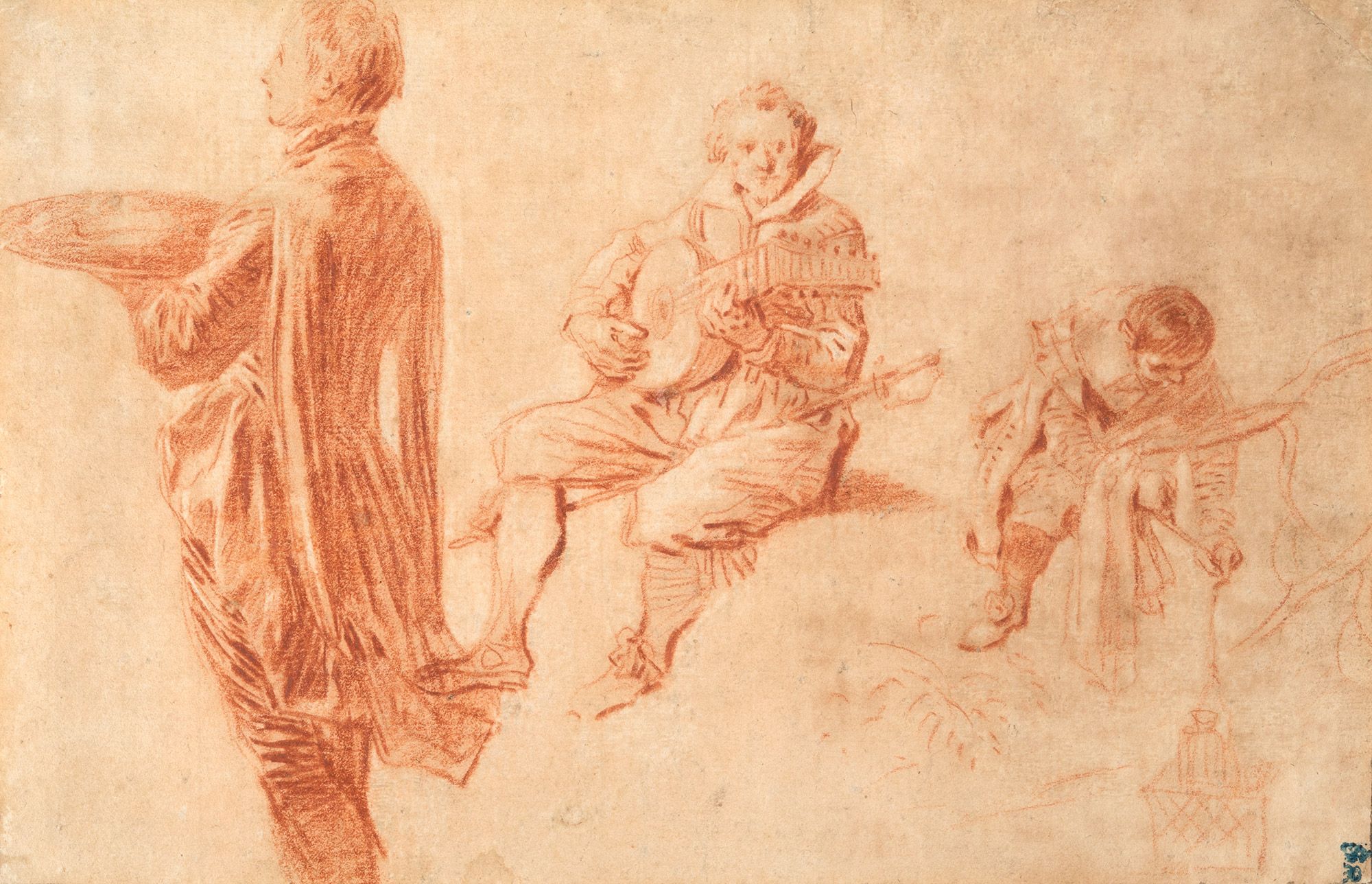FJK 135
Watteau Antoine (French, Valenciennes 1684–1721 Nogent-sur-Marne)
A Servant Holding a Dish, a Seated Musician, and a Leaning Valet Pulling a Bottle
ca. 1714-1715
5 19/32 × 8 21/32 in. (142 × 220 mm)
Medium
Red chalk heightened with white chalk on brown laid paper
Framing line in pen and brown ink
Collector’s mark “C. de Valori” bottom right (Lugt 2500)
Origin
Marquis Charles de Valori Collection (1820-1883), Paris
His sale, Paris, November 25-26, 1907, no. 247 (1905 francs to Rublin?)
Atherton Curtis Collection, Paris
Otto Wertheimer Collection (1878-1972), Paris in 1957
Mrs. E.F. Hulton Collection (1957-1972)
His sale, London, Sotheby’s, December 8, 1972, no. 13
Dr. Anton C.R. Dreesmann Collection, Amsterdam (Acc. no. B-27)
His sale, Christie’s, London, April 11, 2002, no. 603
Jan Krugier Collection, Monaco, JK 6032
Jan Krugier Foundation
Bibliography
GONCOURT Edmond de, Catalogue raisonné de l’œuvre peint, dessiné et gravé d'Antoine Watteau, Paris, 1875, under no. 48.
ZIMMERMANN E. Heinrich, Watteau, Stuttgart & Leipzig, Collection Klassiker der Kunst, 1912, p. 187 (French edition: p. 176).
MILLER Valentine, “The Borrowings of Antoine Watteau,” in The Burlington Magazine, LI, 292, July 1927, p. 38.
PARKER Karl Theodor, The Drawings of Antoine Watteau, London: B.T. Batsford Ltd., 1931, p. 24, note 6.
MATHEY Jacques, “The early compositions of Antoine Watteau in the style of the Dutch and Flemish painters,” in The Art Quarterly, XX, 3, 1957, p. 248.
PARKET Karl Theodor, MATHEY Jacques, Antoine Watteau.Catalogue complet de son œuvre dessiné, Paris: F. de Nobele, 1957, vol. I, no. 331, p. 47.
MATHEY Jacques, Antoine Watteau, Peintures réapparues, inconnues et négligées par les historiens; identification par les dessins; chronologie, Paris, 1959, II, p. 25.
MIRIMONDE Albert Pomme de, “Les sujets musicaux chez Antoine Watteau,” in Gazette des Beaux-arts, LVIII, November 1961, pp. 270, 289, note 39.
MIRIMONDE Albert Pomme de, “Les instruments de musique chez Antoine Watteau,” in Bulletin de la Société de l’Histoire de l’Art français, [1962], 1963, p. 48, note 1.
EIDELBERG Martin P., Watteau’s Drawings, Their Use and Significance, New York & London: Garland Publishing, 1977, p. 202, note 29.
JEAN-RICHARD Pierrette, Musée du Louvre, Cabinet des Dessins. Collection Edmond de Rothschild. Inventaire général des gravures. Ecole française I. L’œuvre gravé de François Boucher dans la Collection Edmond de Rothschild, Paris: éd. des musées nationaux, 1978, under no. 127.
ROLAND-MICHEL Marianne, Watteau. Un artiste au xviiie siècle, Paris: Flammarion, 1984, p. 230.
EIDELBERG Martin P., “Review of the exhibition Antoine Watteau, 1684-1721 (Washington, National Gallery 1984-1985),” in Master Drawings, XXII-XXIV, I, 1986, pp. 102-103, note 38.
ROLAND-MICHEL Marianne, Watteau and England, Rococo in England, London, 1986, p. 48, note 10.
MORGAN GRASSELI Margaret, The Drawings of Antoine Watteau, stylistic development and problems of chronology,Ph. D. Harvard University, 1987, unpublished, I, pp. 389-390, no. 230, fig. 481.
EIDELBERG Martin P., “Watteau’s Italian reveries,” in Gazette des Beaux-Arts, CXXVI, 1995, p. 131, note 89.
ROSENBERG Pierre, PRAT Louis-Antoine, Antoine Watteau (1684-1721). Catalogue raisonné des dessins, Milan: Leonardo Arte, 1996, vol. I, no. 353.
Notes
The two figures on the right were engraved in reverse by François Boucher for the Figures de différents caractères (P. Jean-Richard, 1978, no. 127)
The musician, without his sword, appears in L’amour paisible (D.V. 268, fig. 353c): this is one of the rare examples of the reuse of a figure borrowed by Watteau from another artist (see also no. 245).
L’amour paisible is often considered as a work from the English period, but the reuse of such a drawing encourages dating the painting to around 1719, before the artist’s trip to England. The sheet can be dated to around 1715 (1717 according to Grasselli).
It is hard to decide whether the figure on the left, most likely copied after an old painting, was done at the same time. Its design looks more synthetic, but the musician’s foot seems to be drawn over the lower part of his clothing. Though his fine and delicate face could date from 1714.
We can also notice that Boucher only etched the two figures inspired by van de Venne. He brought them closer to each other by the artifice of a mound, a tree trunk and some foliage. Furthermore, he extended the tree towards which the young boy is leaning, unless Watteau’s drawing was cut on the right, which cannot be excluded. (P. Rosenberg, L.A. Prat, 1996, p. 568).
Request for information/loan
The Jan Krugier Foundation is devoted to increasing the impact of the collection of drawings through regular loans to major exhibitions. Loan applications should include a complete presentation of the project.

